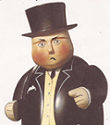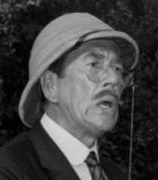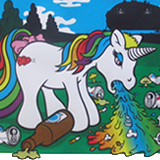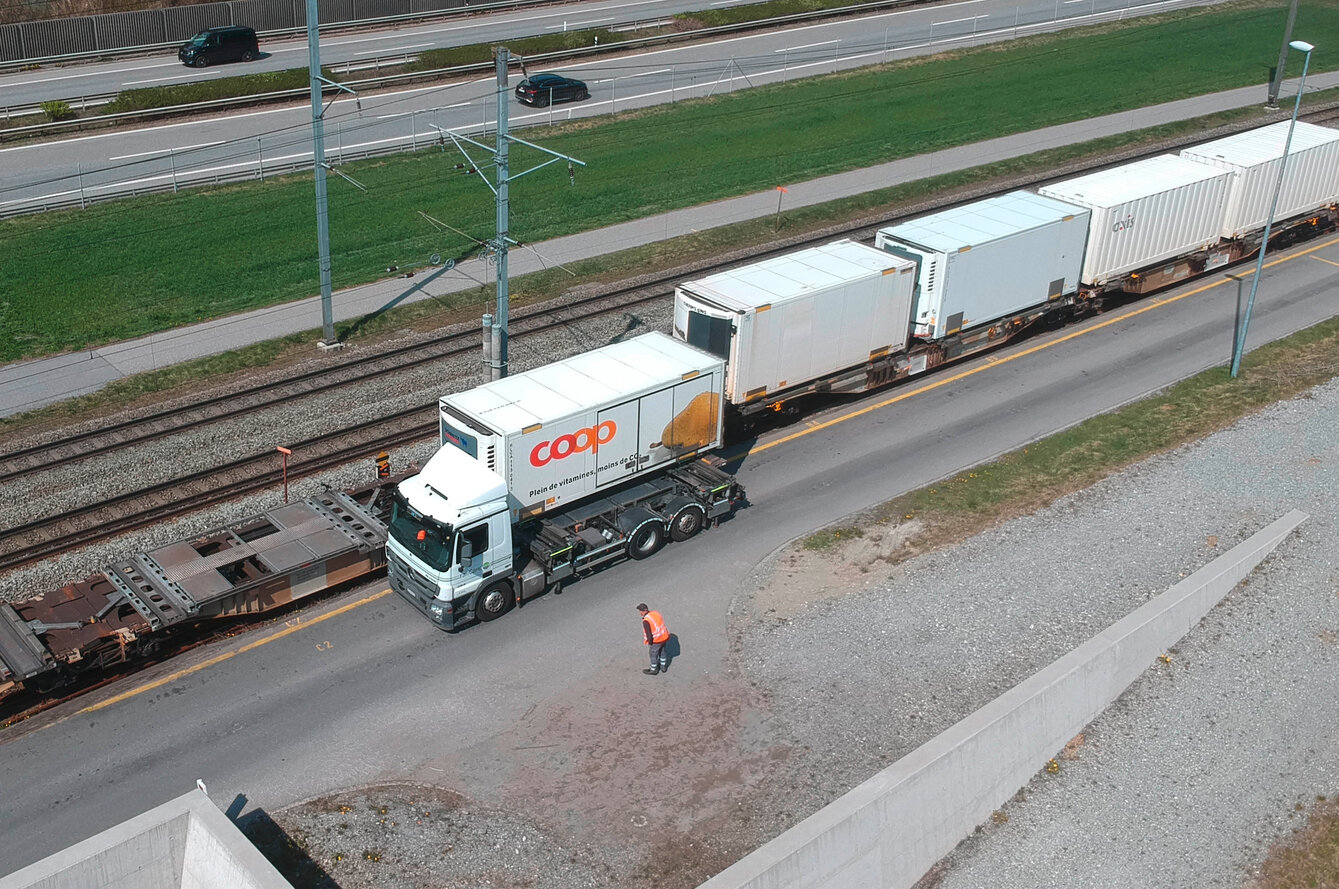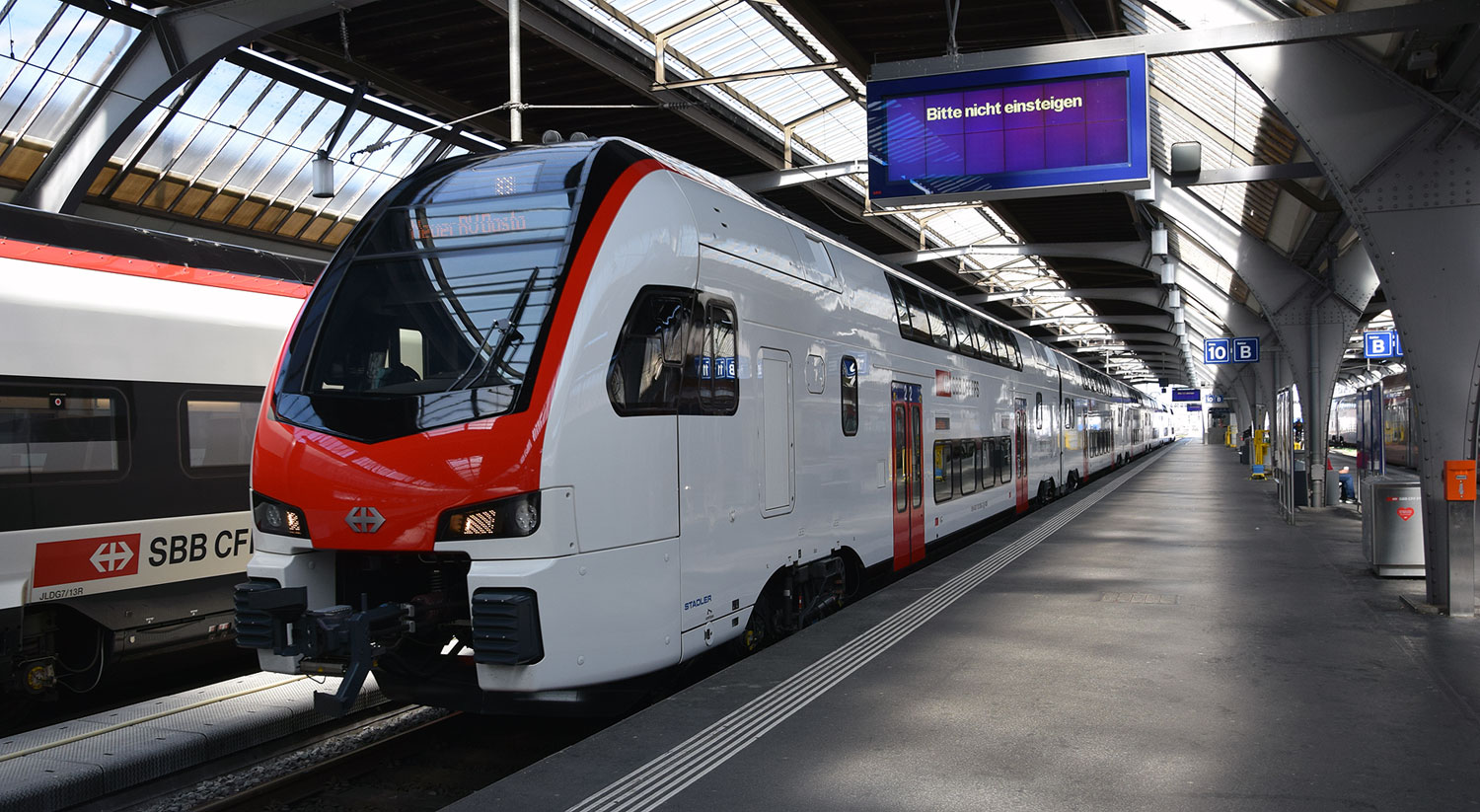|
Now's the time for a recap of the past couple of weeks. I've been a bit too busy to post, so 2 trips in one post As usual, you can follow along here : https://s.geo.admin.ch/9fd6acaf73 The first engineer I accompanied had a two-parter day : an early afternoon run from Lausanne-Triage to Geneva and back was followed by something rather different. In order to increase operational robustness, mainline locomotive engineers (licence category B) are also qualified on our shunting locos. In order to keep this qualification, they need regular practice. Therefore, the mainline engineers regularly get assigned to tours that are usually staffed by junior local train engineers (licence category B100). So our locomotive for the evening was an Am843, powered by a 52l, 2000 horsepower V12. Yes, even the Swiss railways sometimes need to use diesel. Since this was a shunting operation, a member of the shunting staff came along with us, in order to form the trains and do the indirect driving.  The drivers' controls in the Am843. From left to right : direct brake lever (out of frame), automatic brake lever, power lever and reverser buttons.  You need a long hood for an engine that big. Our first task was to bring 2 wagons of gravel to a customer in Vufflens, remove 2 wagons of dirt from their premises, and finally remove some wagons of palletized goods from the warehouse/distribution center of another customer. Then all the removed wagons would be brought back to Lausanne-Triage. The way to Vufflens is quite short, at just under 10km. We then began the slow task of shunting wagons back and forth on the customer's low speed private line.  5km/h is really slow.  But once things had been sorted out, we were dumping 80 cubic meters of gravel and leaving 2 wagons to be filled during the next workday.  Then we moved on to the next customer and picked up the wagons that were waiting for us. You can see the shunting staff member (my best translation for the french agent de manoeuvre) on his way to check the wagons for readiness and safety. After getting off the branch siding, we announced our readiness for departure 10 minutes behind schedule, but since rush hour was past, the traffic control center was able to get us on our way quickly. We dropped off our train at Lausanne-Triage, then went with the locomotive to our final customer of the day in Cossonay. There we would again have a handful of full goods vans waiting for us. Quick and easy : back in, hook up the wagons, technical check and go. Overall, it was a very interesting experience, but not one that's particularly popular with the mainline engineers : they feel the shunting work is beneath them, and the resent the extremely tight schedules that shunting staff are held to. The week after that, I went along on one of our longest tours : Lausanne-Triage to Basel and back. Basel is the main entry point for cargo in Switzerland, be it by road, rail or riverine barge traffic. It's an absolutely critical hub, and multiple trains a day run between Basel and the french speaking part of Switzerland. The train left Lausanne-Triage on time, at 08:16. Our route would follow the Jura Foot Line all the way to Olten, then we'd cross the Jura mountains through the Hauenstein Base Tunnel and follow the Ergolz river to the Rhine and Rangierbahnhof Basel.  The drivers' cab allows for some seldome seen sights, like driving through this archway at the Château de Grandson. Generous reserve time is planned, as the train follows very busy lines during the morning rush. This includes two planned 20 minute overtake stops, as well as extra travel time in case we would have to run behind a regional train (average speed in that case is nearer 50km/h than the usual 100km/h most freight trains run at).  The stretch between Solothurn and Olten is the logistical heart of Switzerland. It's the site of 2 major highway interchanges and houses the largest and most important distribution centers of almost all retailers and logistics businesses. As an example here, a glimpse at the Härkingen sorting center and intermodal terminal of the Swiss Post.  It's also where the main material depot of SBB Infrastruktur is located Luck definitely was on our side. We made such good time that the first overtake stop was canceled, and we encountered no particular slowdown until Olten. In Olten, our second scheduled stop was upheld, and we waited for 20 minutes before being given the green light on towards Basel. The line between Basel and Olten is incredibly busy, as it's the main feeder to the Gotthard line for freight and also has many InterCity and regional trains (including the Basel S-Bahn) using it. We made it to Basel a massive 45 minutes ahead of schedule, and were confronted with of the special features of the Rangierbahnhof.  Instead of using shunting locomotives to hump incoming trains, the system in Basel relies entirely upon gravity. Incoming trains are held on a slope by retarders, which are then released in order to hump the train. Now, this requires a lot of precision from the engineer in order to bring his very heavy train with slow applying brakes to a precise stop on a slope, in such a way that the first wagon is properly held by the retarder. It's a tricky operation and in our case, the engineer came to a stop too early, so the retarders were lifting the locomotive by its pilot (cowcatcher). Once that problem was solved, and the locomotive parked on a siding, we had a nice long lunch break . I highly recommend the burgers at the cafeteria of the local college.  Our train firmly held in place. Around 13:45, we got our next locomotive ready, hooked to a train in the southbound departure yard and left on time at 14:22. Since the run back to Lausanne-Triage mostly avoids peak hours, a bit less reserve time is alotted. We made good speed until after Olten, and thereafter had to plod on all the way to Neuchâtel at low speed behind various regional trains.  Lakeside running after Biel.  Château de Neuchâtel. After Neuchâtel, we briefly picked up speed, before having to make our planned overtake stop in Colombier.  Full speed through the vineyards after Colombier. Once the InterCity had passed us, we resumed our route and were able to arrive on time at 17:34. All that was left to do was uncouple the train and park the locomotive.
|
|
|
|

|
| # ? May 10, 2024 07:21 |
|
I always feel bad when someone does a really long, comprehensive and interesting post like that and I can't find anything specific or insightful to say. But I really enjoyed reading it, so thanks  Had an afternoon out at a heritage railway yesterday:    Because of the prolonged dry, hot weather there was a diesel shoving at the back to save the steam engine working too hard on the climbs and risking embers/sparks flying into the fields. Class 37 in faded Trainload Metals 
|
|
|
|
Make sure to check the spark arrestors on your steam locos. It's the third time since 2012 the VR Hr1 nr. 1009 sets bushfires that destroy trackside equipment. This time they burnt down a wagon too. 
|
|
|
|
I'm going to Switzerland later this summer for 10 days (flying into Geneva, then staying in Lausanne, Zermatt, Zurich, and Murren before flying back out of Geneva). We do have a healthy number of trains on the itinerary, in part because the trip is to celebrate getting my MA in Transportation Policy, like the Glacier Express and the Jungfrau Railway. On a previous trip, we did the Bernina Express and didn't feel the need to retread that. Given that I've already seen the Landwasser Viaduct and Brusio spiral viaduct, what else should I be on the look out for as I go back and forth across the country? I'm also planning on keeping an eye out for SBB Cargo, as I didn't have much of an opportunity to do so on the previous trip. My impression is that the system is mainly in the northern part of the country. Is that correct? The only other time I was in Switzerland, we didn't get into Geneva until twilight and it was dark by the time we got into Zurich. The next morning was a very early train to St. Moritz. Barely even remember seeing anything freight.
|
|
|
|
Sash! posted:I'm going to Switzerland later this summer for 10 days (flying into Geneva, then staying in Lausanne, Zermatt, Zurich, and Murren before flying back out of Geneva). We do have a healthy number of trains on the itinerary, in part because the trip is to celebrate getting my MA in Transportation Policy, like the Glacier Express and the Jungfrau Railway. On a previous trip, we did the Bernina Express and didn't feel the need to retread that. Given that I've already seen the Landwasser Viaduct and Brusio spiral viaduct, what else should I be on the look out for as I go back and forth across the country? Congrats on that degree ! Some cool trains to take would be :
Freight trains in Switzerland have two main axes of operation :
If you want to see a freight train, the best way to do so is to hang out at the station between the passenger pulses. That's usually when the freight train paths are scheduled. On most lines, there's one freight train an hour at best, so they're easy to miss.Otherwise, if you go to the Gotthard line, for example in Arth-Goldau, you'll see platoons of freight trains at 3 minute intervals every 30 minutes. BalloonFish posted:I always feel bad when someone does a really long, comprehensive and interesting post like that and I can't find anything specific or insightful to say. But I really enjoyed reading it, so thanks Thank you for enjoying it  It's a good exercice for me to write these posts, so I'm happy if they're enjoyed as well. It's a good exercice for me to write these posts, so I'm happy if they're enjoyed as well.Gorgeous trains. English steam locos really are spectacular. Now, back to SBB Cargo railway operations. On Monday, I went along for a tour that started off fairly routine, but finished in a more interesting way. We started off at 10:03 to run a single Re620 to Geneva to pick up a string of cars to bring back to Lausanne-Triage. After a 20 minute delay because of a broken down train on the line, we drove at pace to Geneva. 140km/h really feels quite fast after running at 100km/h maximum until now. At this point, Lausanne-Geneva is starting to feel routine to me.  Our Re620 ready to leave for Lausanne-Triage after the brake check. Then, after a 1 hour reserve time and 1 hour break, we took a fairly special train from Lausanne-Triage to Geneva. Extensive track renewal is underway between the two stations, so we had an Re420 hauling three Scheuchzer track renewal machines. The first was delivered in Nyon, and the last two in Geneva.  Waiting in Nyon for the operations center to tell us which machine to unhook. Notice the Re420 in the classic dark green livery. After unhooking the last machines in Geneva, we parked the loco and took a passenger train back to Lausanne. On the way, we could get another look at the machine we delivered to Nyon:  This coming week, I'll be riding along with those engineers who work nights. It's going to be a rough schedule, but there'll be some interesting trains. I'm looking forward to it.
|
|
|
|
BalloonFish posted:I always feel bad when someone does a really long, comprehensive and interesting post like that and I can't find anything specific or insightful to say. But I really enjoyed reading it, so thanks Oh hey, I recognise that line! I wonder if they have the arguably worst diesel ever built for BR back there yet?
|
|
|
|
Itzena posted:Oh hey, I recognise that line! I wonder if they have the arguably worst diesel ever built for BR back there yet? That is a field with some strong competition - doesn't narrow it down much. But if it's the one I think you mean, I believe it was still at the Severn Valley Railway when I visited the C&PR.
|
|
|
|
Ah yes, looks like it: https://www.youtube.com/watch?v=ZpuI-7tLdR4
|
|
|
|
For those who like trains and also play Train Simulator 20xx/Classic, I've listed some DLC keys over in the games sub-forum here.
|
|
|
|
Freight train needs a little push: https://www.youtube.com/watch?v=icgH_3dXdOU
|
|
|
|
Forgive me if station posts, rather than the trains themselves, are off-topic, but thought the thread would appreciate: 
|
|
|
|
Went on a train ride for the 4th:
|
|
|
|
What's that fifth vehicle? Can't quite make it out, is it covered seating or something?
|
|
|
|
Yeah it's an outdoor seating car. People are only ticketed for the passenger cars, but they have these outdoor cars every so often so you can go outside and look at the scenery. Most people didn't stay out there because this is Arizona in the summer and it was 110+F
|
|
|
|
https://m.youtube.com/watch?v=lsVeXeulUg0 It's 50 years of the Great Central Railway heritage line, and to mark it they hitched a Standard 9F to 50 freight wagons. It's been a while since a 9F was worked that hard, and even longer since the drumroll of several dozen short-wheelbase wagons moving at a decent speed on jointed rail was heard. The consist is decidedly inauthentic (hence all the brake vans dotted throughout it and the unfitted mineral wagons being in the middle between the tank wagons and fitted vans) but I think it makes it look like when, as a kid, you decided to connect together every item in your train set.
|
|
|
|
Mustache Ride posted:Yeah it's an outdoor seating car. People are only ticketed for the passenger cars, but they have these outdoor cars every so often so you can go outside and look at the scenery. That would be incredible on a nice day
|
|
|
|
BalloonFish posted:https://m.youtube.com/watch?v=lsVeXeulUg0 I think it will have been worked harder in preservation, but it's spot on that it will have been a very long time since a train of wagons like that was hauled. I'm guessing it's drawing in the region of 350t there? The gradient through Quorn in that direction is 1 in 330 ascending. 92214 used to be based at the Moors and will have been used on diner trains. That will have been eight coaches for a weight of over 300t-ish - but the incline to Goathland is three miles at 1 in 49. The owner at the time (Stuart) decided to call it "Cock o' the North" - I never did find out if he knew about the P2 that carried that name - and it was painted black then, so it immediately became known as "Stuart's big black cock".
|
|
|
|
Noosphere posted:The Montreux - Oberland Bernois between Montreux and Interlaken. I'm reasonably sure this is the only item you suggested that actually made it into the list. Had to keep the wife happy too. We're a bit over halfway through the trip. Right now, I'm sitting on our balcony in Mürren. Close enough to the station that I just heard the BLM pull in. We flew into Geneva and immediately departed for Lausanne. We went on short trips to Montreux and Gruyeres. For reasons I don't exactly recall, we ended up in Fribourg too. I did catch multi freight trains while we were in Montreux. After that, we left for Zermatt. Our hotel required a trip up the Gornergrat cog railway. I was surprised to see that it had a freight component and I was able to watch them doing some shunting at the Zermatt station. Our hotel even had a tram of its own. The big leg was the Glacier Express from Zermatt to St Moritz, then a train from St Moritz to Landquart, and capped with Landquart to Zurich. We had no clue that Züri Fäscht was happening and our hotel was right in the middle of the tram closures. We did have dinner at a restaurant that overlooked Zurich HB. I noticed both on trains and watching the station that it seems a proceed signal doesn't turn to the danger signal when the front of the train passes. Is that correct? In North America, a green drops to red almost as soon as the locomotive passes the signal. In the station it didn't seem like they changed at all. I assume there's some fundamental rules that I don't understand. It almost seems like the default aspect is "proceed" rather than "stop." Between Zurich and Bern on the way to Mürren, I saw a lot more freight. I find the covered goods wagons interesting, because they're completely unknown in North America. We flirted with them in the 1960s and 70s for lumber traffic and they were sort of a disaster. I also noticed containers that looked slightly larger than the 20 foot ISO container that appeared to be in domestic service (companies like Coop). Is there some kind of European container that doesn't travel overseas? It also jumped out how there's very few wagons that aren't owned by the railroad, with the exception of VTG and GATX tank cars. I really like the Stadler bilevels that seem to be everywhere. California bought some, but I don't see how they're doing that. I was taken aback by how poor the Swiss trains are from an accessibility standpoint in ways we could never get away with in the US. Like how you have carriages with level boarding into the second class seating, but stairs into the first class area. Also completely shocked at the honor system that is in play for tickets outside of the IC or scenic trains. There's some pretty huge differences in society here. The little children's area on some trains was neat. We're heading back to Geneva in a few days before flying back to NYC and taking Amtrak home. The trains here aren't much faster than the NEC, but their time keeping is beyond our abilities.
|
|
|
|
Sash! posted:I really like the Stadler bilevels that seem to be everywhere. California bought some, but I don't see how they're doing that. They're actually already in testing: https://www.youtube.com/watch?v=ASTqm1A7kZg
|
|
|
|
I've got The Office on as background noise, and got to wondering how they got permission for Steve Carell to hop on a moving freight train, which just happened a few minutes ago.
|
|
|
|
TITTIEKISSER69 posted:I've got The Office on as background noise, and got to wondering how they got permission for Steve Carell to hop on a moving freight train, which just happened a few minutes ago. Look at the cars in the background. It's a http://www.fwry.com/Equipment/Locomotives.html that RB1992 EMD GP35 can be seen in the shot. e: apparently that same area also has this. Be your own train. https://www.sunbursttrain.com/ e2: here's the train yard the office scene was filmed. the newest street view it's empty but in the 2015 it's filled with trains and cars. https://www.google.com/maps/@34.399...i6656?entry=ttu Powershift fucked around with this message at 02:41 on Jul 10, 2023 |
|
|
|
Cool, thanks!
|
|
|
|
Chenghiz posted:They're actually already in testing: I saw in the comments that they have upper and lower level doors to accommodate the ADA requirements. That's got to look weird.
|
|
|
|
Sleepy train taking a nap under a bridge Thankfully no hitting the bridge at speed https://en.wikipedia.org/wiki/Granville_rail_disaster
|
|
|
|
drunkill posted:Sleepy train taking a nap under a bridge that'll buff out
|
|
|
|
drunkill posted:Sleepy train taking a nap under a bridge Is that the derailment yesterday under DC? The location looks about right for the tunnels there.
|
|
|
|
Yeah that's the First Street Tunnel.
|
|
|
|
Sash! posted:I'm reasonably sure this is the only item you suggested that actually made it into the list. Had to keep the wife happy too. We're a bit over halfway through the trip. Right now, I'm sitting on our balcony in Mürren. Close enough to the station that I just heard the BLM pull in. That sounds like a really nice trip, definitely a great way to celebrate getting your degree. Some remarks :
So 3 weeks ago I spent all week accompanying those train engineers who have an exclusive night contract. For context, regulations stipulate that no employee should work more than 15 in 28 days between midnight and 04h00 (the so-called night hours). A exclusive night contract, on the other hand, requires that the employee only work shifts that contain night hours. It was a tiring week, since even though I’m more of an evening person, actually staying up all night is something that I’ve very rarely done. As usual, you can follow along on the map here : https://s.geo.admin.ch/a085104619 I began on monday at 20h36, with the departure to Rangierbahnhof Limmattal (RBL). A big shunting yard outside of Zurich, that serves all of eastern Switzerland. The engineer this evening commutes over from neighboring France, and greatly appreciates the reversed commute pattern ; always traveling opposite to the traffic jams. The drive to RBL went quite smoothly, with a 20 minute wait just after Solothurn to let a platoon of freight trains using both tracks pass us in the opposite direction. We arrived in RBL, and uncoupled the train and parked the locomotive for a 1h break. The cafeteria would be the nicest break room all week. Afterwards, we picked up another locomotive and shunted over to the head of the sorting tracks to pick up our train for departure. Just like Basel, RBL also has a particularity : the sorting tracks are equipped with Dowty Retarders for keeping the speed of the humped wagons stable after their passage through the main retarders. Since we were leaving towards the west, we had to pull our train out of the yard through the Dowty Retarders. It was an agonozingly slow start, with the maximum allowed speed being 5 km/h until the rear of the train had finally cleared the retarders. As I’ve said before, Switzerland has an extremely busy train network. As passenger train numbers diminish, and then almost entirely disappear between 01h00 and 04h00, heavy maintenance is done on the tracks at night. This means that delays and re-routing are routine for the nightly freight trains. On this day, we were re-routed from the direct line (Neubaustrecke / Bahn 2000 line) between Olten and Bern to the old line via Burgdorf. It’s quite sinuous, with some curves restricted to a mere 75km/h. We then ran though an utterly deserted Bern train station, with all but two tracks occupied by waiting passenger consists. It’s striking at night, just how many trains are parked in basically every single free station track or siding. The logistics of getting that many engineers to their widely dispersed trains in the early morning must be daunting. We continued towards Lake Geneva, what felt to me like plummeting down the grades as we went. Riding along at night really emphasized to me how little control the engineer has if something unpredictable happens right in front of him. In Puidoux, we gave the train over to a morning shift engineer who would drive it to Valais, while we took his locomotive back to LT. Going over the flyover between Lausanne and Renens at 120km/h was fun. We arrived slightly behind schedule, just after 05h00. https://www.youtube.com/watch?v=4NtMsQ9Ou-Q Tuesday, I went along with the nightly intermodal train. SBB Cargo runs several intermodal terminals for truck trailers. The trucking companies drop off the trailers during the day and the next morning at the start of legal trucking hours (05h00), their trailers are ready to go on the other side of Switzerland. 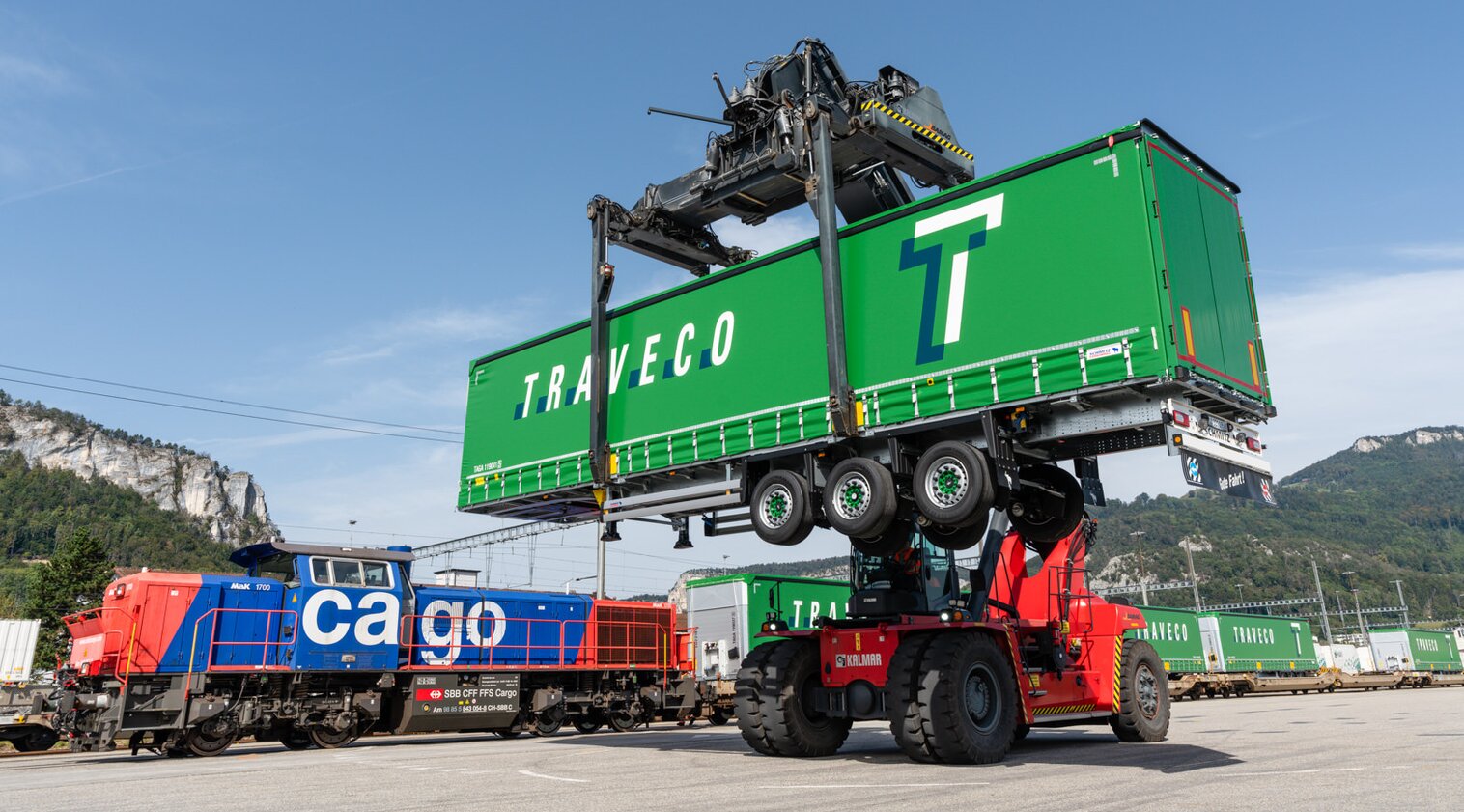 A speciality of this operation is that it is SBB Cargos’ automatic coupler pilot project. All the intermodal wagons use a Scharfenberg coupler instead of the standard buffer and chain.  Scharfenberg couplers seen from the cab. This permits extremely fast coupling and de-coupling. We began by relieving an engineer who’d come from the intermodal terminal in St-Tryphon at 20:36, then drove to the terminal in Renens to pick up that days’ cars. This required some shunting in order to retrieve the cars from the loading area, then coupling them in front of the cars we’d come with. Once that was done, we were on our way to the Dottikon Umspannanlage, or Dottikon Recoupling Installation. Back before the Gotthard base tunnel opened, trains that were too heavy to pass the summit line were split and reformed here. Nowadays, with the base tunnel allowing a single locomotive to pull 1700 tons (compared to 2 locos for 1400 tons on the summit line), the need for this installation is nearly nonexistant. So nowadays, it has been repurposed as a shunting yard for intermodal traffic.  Dottikon Umspannanlage  An intermodal train being shunted Trains from all over Switzerland converge on Dottikon, their cars shunted according to their destination terminal, and the trains then go back to where they came from with a new consist. The shunting crew in Dottikon operate on a very tight schedule, and any delay of an incoming train will make all departing trains late, which means that the truckers will have to wait for their loads. After just over an hour, our new train was ready for us, and we were on our way to Renens. Once again having to go through Burgdorf because the direct line was being worked on. We arrived in Renens at 04h05, and spent the next 45 minutes shunting the cars over to the terminal. Since it, of course, doesn’t have an overhead wire, we first needed to pick up a rake of empty cars in order to lenghten the train enough that the wagons would make it to their destination. Even with this, we were perilously close to the end of the catenary, and the engineer had to poke his head out of the window to keep an eye on the pantograph. After uncoupling our cars, we arrived and parked our locomotive in LT, slightly ahead of time around 05h15. Wednesday, we went to Basel. This was the heaviest train all week, at just under 1200 tons. But with a maximum planned weight of over 2000 tons, this train runs with a so called Re 10/10. In other words, a multiple unit with an Re 420 and an Re 620 pulling the train together. Due to amperage restrictions, multiple units cannot use their full solo power, but such a duo is capable of over 15’000hp.  Re 10/10 ready to go. As a sidenote, these locomotives can run in any combination of Re 420 and Re 620 as multiple units, up to 20 axles. But any use other than an Re 10/10 is vanishingly rare. The multiple unit had already been prepared for us by another engineer (more on that Friday). After leaving LT just before 19h, we made our way to Basel, with a stop to let an ICN and 2 regional trains overtake us near Neuchâtel, and a further stop in Olten. Once in Basel, we parked the cars in the retarder, and parked the locomotives separately, ready for their return journey to LT. We then took the regional train to Olten, arriving there shortly after midnight, where we would wait until 01h30 to relieve the engineer of a train from RBL. He arrived on time, and we were promptly on our way. Once again going though Burgdorf. This night there was a lot more trackwork between Bern and Lausanne, which slowed us down somewhat, and to the engineers great annoyance, the early morning train to Payerne, which was ahead of schedule, was prioritized over us when our paths crossed. The rest of the way was uneventful, and we arrived around 15 minutes behind schedule, around 04h45. Thursday, I got to discover the postal train service. The Swiss Post is by many measures our most important customer. They own their own high speed wagons, and all the fastest freight trains run for them. Back in the day, there was a mail compartment in every passenger train, and letters were distributed from city to city that way. Now, the Post has giant logistics and sorting centers in several key areas, and dedicated trains run between them at all hours of the day. There are two kinds of postal trains : big packages, which are shipped in intermodal containers, and mail and small packages, wich are shipped in rolltainers. We began by deviating from the prescribed schedule. Instead of taking the bus at 18h36 and using a succession of passenger trains to go to Härkingen, we instead made our way to Renens around 19h30 and hitched a ride on a locomotive that was bringing packages from Daillens to Härkingen. It was an unventful ride, and we arrived with plenty of time to spare. At 22h45, we left Härkingen with a mail train for Eclépens and Geneva. At first we made good time with our maximum speed of 120km/h. However, just after Neuchatel, the track was being completely renewed. So only a single track was usable, and then only at walking pace in the construction area. Unfortunately for us, there were 2 passenger trains and 3 other freight trains trying to squeeze past. So we waited for 30 minutes at a red signal, before finally being able to pass. Now, the Post runs a tight ship, and mail arriving and departing the distribution centers needs to be on time (their tolerance for delay is less than 10 minutes). As we pulled into the mail station nearly 30 minutes late, we could see that they had assembled extra manpower in order to unload the train faster. It was done in 15 minutes, and we were on our way again. The track to Geneva was mostly single track due to work sites all over the place, but at this time of day, traffic was low enough that we could go without stopping. In Geneva, we uncoupled our cars in the passenger yard, then coupled our locomotive to that of the package train and made our way back to LT. We were a bit late when we arrived around 03h45. Finally, on Friday I went along for the complementary service to Wednesday’s. First, the engineer prepared the Re 10/10 for the train to Basel, then we caught the Intercity to Basel in order to arrive there around the same time as the engineer who drove the freight train to Basel. We had a pleasant journey and arrived at the shunting station just as he was going to the passenger station for his train to Olten. After exchanging some pleasantries, we then waited for our prescribed departure time, before heading to the Re 10/10, and going through the full safety checklist (needs to be done once per calendar day), then going to get our consist. We departed Basel on time, but the construction work on the Jura Foot Line and the Neubaustrecke direct line caused us to be rerouted via the old Burdgdorf line. For a train from Basel to go through Bern is rare indeed. But it goes to show how much of an effort had to be made by the network dispatchers the previous evening in order to keep delays down to 30 minutes. This far longer way added a substantial amount of time to our trip. In addition, we had to wait for 15 minutes at a signal for the middle of the night regional train to cross us at yet another construction site. So despite an otherwise uneventful trip, we arrived in LT on Saturday at around 04h30, or over 45 minutes behind schedule. All in all, a very interesting experience. The night trains have far less interrupted train paths, which means that there are far fewer crew changes compared to the daytime traffic. During the day, the main difficulty for the engineers is to deal with the large number of passenger trains and all the resulting caution or stop signals. During the night, the sheer amount of trackwork can cause delays or send the train on a line that the engineer hasn’t run in months or years. Noosphere fucked around with this message at 11:16 on Dec 18, 2023 |
|
|
|
During the stay in Mürren, I had more time to study what I came to realize was the most fascinating and entirely Swiss freight movements I've ever seen. To get to Mürren, we transferred from the SBB to the Berner Oberland-Bahn at Interlaken Ost (by the way, if any of you ever find yourself there, there's a spot on the Aare just west of the station where there's a railway bridge that might be one of the finest trainwatching spots anywhere) and that takes you to Lauterbrunnen. At Lauterbrunnen, one crosses the street to take the cableway to ascend to Grütschalp. When it is busy, which it was when we were inbound on the first day, they take your luggage and you get it back at either Winteregg or Mürren, which are the only two stops on the Bergbahn Lauterbrunnen–Mürren atop the 800 meter cliff you just went up. It is almost difficult to articulate the topography in the Jungfrau-Aletsch. When I say it is on top of a cliff, I mean it is on top of a cliff. In Mürren, you get your luggage from a little wagon towed by the single carriage train that took you the rest of the way. My hotel was across the street from the station, so I actively watched everything from luggage to cases of wine to construction materials being brought up by the little wagon. What I hadn't pieced together was how they were doing this from the cableway. Down at Lauterbrunnen, they loaded a cargo module onto the bottom of the cablecar. That one used a regular old forklift. Up at the top at Grütschalp, they had this contraption that I couldn't photograph at all, due to the positioning and objects in the way, but you could clearly see it in motion. It was a funicular forklift, entirely inside the station. When the cablecar stopped, the forklift slid forward and lifted the cargo module out of the bracket that carried it under the cable car. Then, the funicular carried the forklift up to the level where the train was. There, it rotated 90 degrees and deposited the cargo module onto the single wagon that the train would tow. On one hand, I wouldn't be surprised to find out it was the only such device in the world, but also not at all surprised to find out they were everywhere in Switzerland. Either is entirely plausible. The final major leg was the BOB's Golden Pass via Gstaad, which I had sprung for Prestige Class for. That turned out to be a fantastic decision, because the bulkhead behind the operator's cabin was clear glass. You basically got a cab ride. When I'm less jetlagged, I'll pull some pictures off my phone. I've spelled about half of these words wrong on the first try because my fingers just won't listen. That's an interesting size that Coop selected for their containers, yet is pretty close to the size Matson Navigation arrived at when the early battle to determine the base container unit dimension was raging. They'd selected 24 feet, which is 7.32 meters. Those covered goods wagons do seem to function like our failed all-door boxcars. The North American ones were designed to handle lumber and each side had four sliding doors. A lot of lumber moved in boxcars back then and loading through one door was kind of a hassle. They got the idea to take a bulkhead flatcar and put a roof on it and the sides be all doors. On paper, it was a good idea, but the doors often took too much of a beating and wouldn't work properly. Ultimately, they figured it was easier to just wrap lumber in plastic. I'll study those signal rules. The other signal rules that I noticed were that there was a light visible to the driver at level crossings to indicate that the protection was activated and that there was an in-cab orange/amber light that came on with an audible sound when approaching a crossing or signal. Thought that was interesting. And that the Swiss crossing projection activated way earlier than North American ones do. To their credit, I did notice numerous construction projects where the platforms were being raised for level boarding. It was a great trip overall. The last leg, though, was Amtrak down the NEC and it might have been the single roughest train ride I've ever had at any level or country. One of the trucks on our coach was severely hunting and the vibration was extreme. It was enough that my wife told me that she kept looking at me thinking "if he's not reacting, then we're not in danger, but I sure feel scared." The vibration lessened at speeds under about 100 mph and in curves it stopped completely.
|
|
|
|
https://www.youtube.com/watch?v=jcfPKB9x8p0 this ain't yer burnin coal, this here's yer cokin coal for metalurgy.
|
|
|
Jonny Nox posted:https://www.youtube.com/watch?v=jcfPKB9x8p0 filled with the sudden desire to fire up Workers and Resources Soviet Republic
|
|
|
|
|
Sash! posted:During the stay in Mürren, I had more time to study what I came to realize was the most fascinating and entirely Swiss freight movements I've ever seen. The Mürren cargo module is really cool. Since the village has no road connection to the outside world (except for a forest track appropriate only for off-road vehicles), all freight for the village has to use the gondola and the train. I've not heard of other such exact load handling devices, but all passenger gondolas can and do carry freight for the destinations they serve. Your timing for the Prestige Class was good. These trainsets were taken out of service shortly after their introduction because the wheel geometry was damaging track points. As the necessary tweaks to the bogies are being made, they are being phased back into service. The Coop containers are simply standard interchangeable truck freight boxes. 2 axle light trucks in Europe have a maximum bed length of 7.5m, and these containers are meant to fit them. The other intermodal container standard in wide use in Switzerland is the ACTS container. A notable use case for them in my area is bringing trash up to the incinerator in Lausanne : instead of having dozens of trucks go through the city each day, they dug a train tunnel. The intermodel ACTS containers are picked up at several stations all over the area and then shoved up the tunnel to the incinerator. 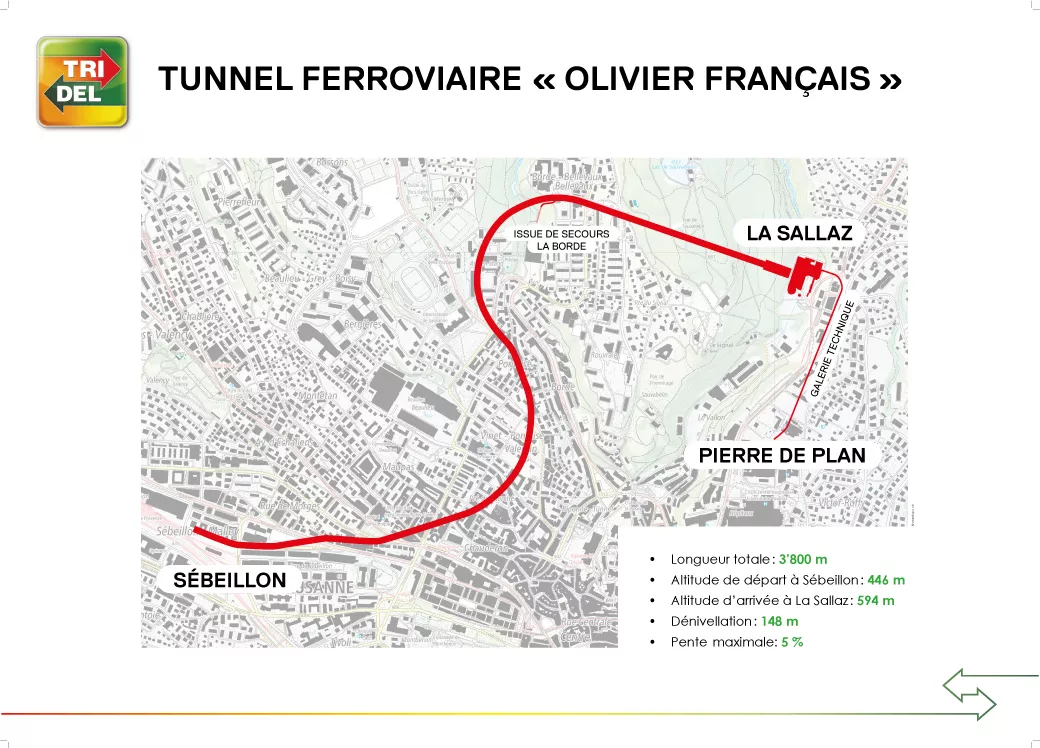  Sash! posted:
Let's talk signals ! The standard gauge network has 3 kinds of signals : L type signals, N type signals and in-cab signaling with ETCS level 2. L type home signals look like this :    With distant signals that look like this :    N type signals look like this : They can act both as home and distant signals. There are in some places dedicated distant N type signals : L and N type signals are used interchangeably. In general, if the signalling on a stretch of line has been redone in the past 15 or so years, it's going to be N type, while older signals are L type. On certain lines, signal types will switch 3 or 4 times. The amber light and beeping you heard is the acknowledger : unpon passing a distant or home signal which orders you to slow down, the acknowledger will beep 3 times and flash. If the engineer doesn't turn it clockwise, it will then initiate an emergency brake. You can hear it here, as the train passes an L type distant signal displaying  , which means that the next home signal is : , which means that the next home signal is :  and that the train should slow down and prepare to stop. Of course, by the time the train gets there, the next home signal has already opened to and that the train should slow down and prepare to stop. Of course, by the time the train gets there, the next home signal has already opened to https://www.youtube.com/watch?v=Se6ESNEuho4&t=1314s Sash! posted:
The federal Disability Discrimination Act gives public transport authorities until the end of this year to make their services accessible. So the SBB is working as hard as possible to get everything done by the deadline. You can see the accessibility ratings of the stations here : https://maps.trafimage.ch/ch.sbb.ha...89172.55&z=10.2
|
|
|
|
I'm a poor photographer on a phone and an even worse videographer. Especially inside a moving object where the camera is endlessly trying to focus on reflections on the windows. I culled out some of the better or more interesting pictures I took. Turns out that I didn't really take that many. Without getting into the whole thing of it, I've been trying to actually look at my vacations rather than look at everything I've ever seen through a videoscreen or viewfinder.Noosphere posted:The Mürren cargo module is really cool. Since the village has no road connection to the outside world (except for a forest track appropriate only for off-road vehicles), all freight for the village has to use the gondola and the train. I've not heard of other such exact load handling devices, but all passenger gondolas can and do carry freight for the destinations they serve. I don't know why I haven't just looked at Wikipedia when I've been describing it. They have a picture of it. I can't find anything describing another such machine anywhere. They were doing quite a bit of work along the Gornergrat cog railway, including rebuilding one of the stops that appeared to be a ski season one.  This one was coming off the mountain and heading to the transfer platforms in Zermatt. It was still there the next morning.  The Riffelalp station had a small freight house/goods shed. All of those pallets were beer and wine for our hotel.  I'm not one to brag or show off by nature, but we'd saved for years and have stockpiled credit card miles so that we could totally go nuts on hotels. This was the view from our room above Zermatt. While I'm talking about the Gornergrat:  If one was to build a model of this place, you will save on trees. Not much growing when you're 3000 meters up.  And this is a level picture! quote:Your timing for the Prestige Class was good. These trainsets were taken out of service shortly after their introduction because the wheel geometry was damaging track points. As the necessary tweaks to the bogies are being made, they are being phased back into service. We did have an issue with the trainset substitutions. At Interlaken, I did see an inbound Goldenpass the day before at the fantastic trainwatching spot along the river.  The next day when it was our turn for the Goldenpass, BLS subbed in a brand new FLIRT. It was nice and shiny and perfectly clean inside. It wasn't just "they've taken care of this." It was like getting into a new car at the dealer. I mean, no one wants to have equipment subbed on a nominally luxury service, but it could have been worse. At the change of gauge in Zweisimmen, we did get the fancy equipment. Literally the only time it rained on us the entire trip was when we were changing trains there. We had the second/third row behind the bulkhead. Being overly polite, I didn't get right up to the bulkhead and get in the way of the people who had the first row.   I did take a short video of semi-random territory. https://www.youtube.com/watch?v=IHvIra6jlPo On the matter of signals, the only time I actually took a picture of one was this very basic one in Gruyeres.  quote:The federal Disability Discrimination Act gives public transport authorities until the end of this year to make their services accessible. So the SBB is working as hard as possible to get everything done by the deadline. The only station I saw them actually working on was what I think was Wilderswil on the Berner Oberland-Bahn.  They'll probably get this done in the time it'll take us to build like a single ramp at a station somewhere in the US. Random other pictures: Glacier Express   Landwasser Viaduct   It sneaks up on you and is a little tricky to take pictures of from the train. I did take a video of a trip over it, which is a combination of "I'm going to hold my phone up" and "I'm going to look a different direction." I just noticed that one of the people that is in my video happened to be on four of the five trains we were on that day. On train #4, she actually said something to us like "so we've been on the same trains all day and now it just feels weird to not say hello." She was a Dutch woman on a solo Switzerland train tour. We talked about Amtrak for a while and she admired our freight trains quite a bit. https://www.youtube.com/watch?v=pSjfLnvGfq8 Jungfraubahn A little tourist-y, which says something compared to the Glacier Express and the Bernina Express.   Still, an underground train station at 3000+ meters is something.  Frecciarossa in Montreux  I really wanted to get a picture of one of the BLS Re 475s. Of course, the only time I actually had a chance, there was a dang catenary mast in the way. I like them because they're the cousins to our ACS-64s. In a parallel universe where Conrail electrified west of Harrisburg in the 1970s, they'd probably be what NS is running to Pittsburgh.  I was a little surprised to see that the only thing marking the end of a train are those little red and white chevrons?  Dinner in Zurich had a heck of a view.  This was the power on the train that got us to Zurich.  Not a train, but I just can't help showing people this rear end in a top hat.  This was in Lauterbrunnen. I'd have loved to be able to get inside that building and take some better pictures. Lastly, one of Lausanne's metro lines is built is a rubber tired metro built on an old funicular track. It looks like an optical illusion. 
|
|
|
|
So one of the big rail projects here in Melbourne has reached a milestone, the Metro Tunnel (not an actual metro line) which will be connecting two suburban lines in a new tunnel under the city, with 3 brand new stations and 2 new underground sections of existing stations into a single continuous 91km long crosscity line. The tunnel was handed over from the construction consortium to the operator (suburban trains are operated by Metro Trains Melbourne) on the weekend and after the tracks were connected up to the mainline at either end last week and a couple of crossovers removed in preparation for future through-running, during an overnight shutdown the first two test trains finally went through the tunnel where they'll remain for a few weeks of initial testing. The tunnels will be using new Communications based train control (CBTC or High capacity) signalling, with testing of that capability having been done over the past few months on the existing mainline using the same trainsets, which will be switched on permanently next month and replacing the Automatic Block Signalling for a good 30km of the line. The Eastern portal has the new tunnel ramp structure between the up and down Dandenong line tracks, so the cutting had to be widened a little and these new tracks dive below the Dandenong Up, Frankston Line and even the Sandringham line tracks. Unfortunately new underground platforms for South Yarra station (top right) were not built as part of the new tunnel, cost was cited (~2bn estimate) which is a shame as South Yarra has three trainline running through it so it'd be a great interchange, especially with new high density being built in the area. Alas, people will have to go two more stops before they can interchange with the tunnel if they're on the Frankston or Sandringham lines (or interchange further back down the line for Frankston trains) The park at the junction has been a construction site for half a decade now, but has recently been rebuilt and restored as a grassy hill. But now there is a major new substation for the tunnel built underneath and ventilation building built where the TBMs were retrived from that pit on Osbourne street.       And the tracks at the other end of the tunnel that were connected last week  Bonus picture of the Electrical Trades Union shirts for this project  Anyway, big train milestone, hopefully the massive new stations and line opens within 12 months, while stage 1 of another huge tunneling project kicks off soon in the suburbs. Edit: The head of the public transport users advocacy group had a decent short interview about it on tv https://twitter.com/i/web/status/1683729957044748289 drunkill fucked around with this message at 16:36 on Jul 25, 2023 |
|
|
|
I don't think you could reasonably expect South Yarra station to just be offline for 2-4 months for construction either. Those lines it serves are some of the busiest in peak hours.
|
|
|
|
Kinda want that shirt
|
|
|
|
https://twitter.com/JacobRajlich/status/1682476748112265216
|
|
|
|
The Real Amethyst posted:Hello. I recently applied for driver role, passed the initial assessments, (scaat + mini, raat, trfs, trp, rwce, vse and others) had an interview with HR and passed that, and then recently had an interview with the line managers. It's not in the bag yet as have to hear back from them to see if they approve of me for medical. Over a year later but I have an update. I got offered a job driving an intercity DMU but I turned it down because the pay was too little. €47,000 yearly salary. I'm sad because it's a job I would have loved but I can't justify the paycut.
|
|
|
|
He's done a few videos like that for train museum stuff. Here are two I found real quick and compiled into one video: https://www.youtube.com/watch?v=1_2gPMsGt_M He's also done a lot of other touristy attractions, including a number of airplane museums. https://www.tiktok.com/@crabman732/video/7242436664281320747
|
|
|
|

|
| # ? May 10, 2024 07:21 |
|
The National Railway Museum have just posted a video of their most prized possession, the Pacer https://www.youtube.com/watch?v=iWVMmvOswjU
|
|
|
















